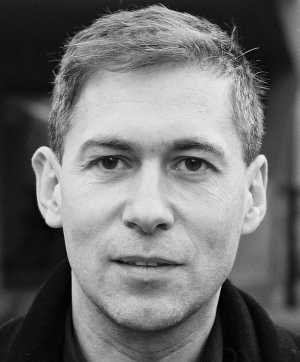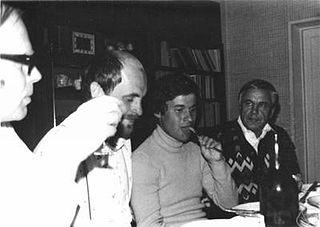Related Research Articles

Bird vocalization includes both bird calls and bird songs. In non-technical use, bird songs are the bird sounds that are melodious to the human ear. In ornithology and birding, songs are distinguished by function from calls.

The Royal Prussian Academy of Sciences was an academy established in Berlin, Germany on 11 July 1700, four years after the Prussian Academy of Arts, or "Arts Academy," to which "Berlin Academy" may also refer. In the 18th century, it was a French-language institution since French was the language of science and culture during that era.

François Diederich was a Luxembourgian chemist specializing in organic chemistry.

The Berlin-Brandenburg Academy of Sciences and Humanities, abbreviated BBAW, is the official academic society for the natural sciences and humanities for the German states of Berlin and Brandenburg. Housed in three locations in and around Berlin, Germany, the BBAW is the largest non-university humanities research institute in the region.

Kai A. Konrad is a German economist with his main research interest in public economics.
The Junge Akademie at the Berlin-Brandenburg Academy of Sciences and Humanities (BBAW) and the German National Academy of Sciences Leopoldina is supported by the two oldest scientific academies in Germany, and represents an interdisciplinary platform for up-and-coming academics. Its membership comprises fifty young academics and artists from a broad range of disciplines. All hail from the German-speaking countries and are committed to interdisciplinary discourse. Each year sees ten new members elected for a period of five years. The Junge Akademie was founded in 2000 as the world's first national institution for the promotion of young academics. Numerous countries have since used it as a model for the establishment of their own national academies for young academics.

Die Marx-Engels-Gesamtausgabe (MEGA) is the largest collection of the writing of Karl Marx and Friedrich Engels in any language. It is an ongoing project intended to produce a critical edition of the complete works of Marx and Engels that reproduces the extant writings of both authors in books of high-quality paper and library binding.
Margit Theresa Rätzsch was a German chemist. She was rector at Technical University Leuna-Merseburg.
The Paul B. Baltes lecture is held annually by the Berlin-Brandenburg Academy of Sciences and Humanities. The lectures commenced in 2008 and are named after Paul Baltes, the German developmental psychologist.

Helmut V. Koch is a German mathematician specializing in number theory.

Johanna Barbara Stachel is a German nuclear physicist. She is a professor in experimental physics at the University of Heidelberg. Stachel is a former president of the German Physical Society (DPG).
Barbara Ruth Albert is a German chemist and rector of the University of Duisburg-Essen. She was Professor of Solid State Chemistry at the Eduard-Zintl-Institute for Inorganic and Physical Chemistry of the Technische Universität Darmstadt. From 2012 to 2013 she was the president of the German Chemical Society.
Regine Kahmann is a German microbiologist and was Director at the Max Planck Institute for Terrestrial Microbiology in Marburg from 2000 to 2019. She was made a Foreign Member of the Royal Society (ForMRS) in 2020.
Bettina G. Keller is a professor for Theoretical Chemistry at Freie Universität Berlin.
Katharina Holzinger is a German political scientist with a focus on international politics. Since 2021, she is the Rector of the University of Konstanz.

Arturo Zychlinsky is a biologist and since 2001 director at the Max Planck Institute for Infection Biology. His research focuses on Neutrophil Extracellular Traps (NETs) which he discovered together with Volker Brinkmann, and the immune function of chromatin.

Matthias Scheffler is a German theoretical physicist whose research focuses on condensed matter theory, materials science, and artificial intelligence. He is particularly known for his contributions to density-functional theory and many-electron quantum mechanics and for his development of multiscale approaches. In the latter, he combines electronic-structure theory with thermodynamics and statistical mechanics, and also employs numerical methods from engineering. As summarized by his appeal "Get Real!" he introduced environmental factors into ab initio calculations. In recent years, he has increasingly focused on data-centric scientific concepts and methods and on the goal that materials-science data must become "Findable and Artificial Intelligence Ready".
Adult neurogenesis is the process in which new neurons are born and subsequently integrate into functional brain circuits after birth and into adulthood. Avian species including songbirds are among vertebrate species that demonstrate particularly robust adult neurogenesis throughout their telencephalon, in contrast with the more limited neurogenic potential that are observed in adult mammals after birth. Adult neurogenesis in songbirds is observed in brain circuits that underlie complex specialized behavior, including the song control system and the hippocampus. The degree of postnatal and adult neurogenesis in songbirds varies between species, shows sexual dimorphism, fluctuates seasonally, and depends on hormone levels, cell death rates, and social environment. The increased extent of adult neurogenesis in birds compared to other vertebrates, especially in circuits that underlie complex specialized behavior, makes birds an excellent animal model to study this process and its functionality. Methods used in research to track adult neurogenesis in birds include the use of thymidine analogues and identifying endogenous markers of neurogenesis. Historically, the discovery of adult neurogenesis in songbirds substantially contributed to establishing the presence of adult neurogenesis and to progressing a line of research tightly associated with many potential clinical applications.
Johannes Heydenreich was a German physicist who researched on the applications of electron microscopy in solid state physics and materials science.
Wolfgang Klein is a German linguist and a founding director of the Max Planck Institute for Psycholinguistics. He's known for his contributions in language acquisition, text analysis and studies on the semantics of time and space.
References
- ↑ admin. "Constance Scharff — Berlin-Brandenburgische Akademie der Wissenschaften". www.bbaw.de (in German). Archived from the original on 2016-02-26. Retrieved 2019-03-07.
- ↑ "Prof. Constance Scharff, Ph.D." www.bcp.fu-berlin.de. 2007-06-01. Archived from the original on 2018-09-19. Retrieved 2019-03-07.
- ↑ Beck, Christina (2002). "Personal Portrait: Constance Scharff" (PDF). Molecular Genetics. Max Planck Research. 3/2002: 72–75.
- ↑ "Research: Zebra finches". 6 June 2007.
- ↑ "Zebra finch genome : Web focus : Nature". www.nature.com. Retrieved 2019-03-07.
- ↑ "Sprache sitzt uns in den Genen". Deutschlandfunk Nova (in German). 29 July 2017. Retrieved 2019-03-07.
- ↑ admin. "Constance Scharff — Berlin-Brandenburgische Akademie der Wissenschaften". www.bbaw.de (in German). Archived from the original on 2016-02-26. Retrieved 2019-03-07.
- ↑ "Constance Scharff". German Academy of Sciences Leopoldina. Retrieved 26 May 2021.